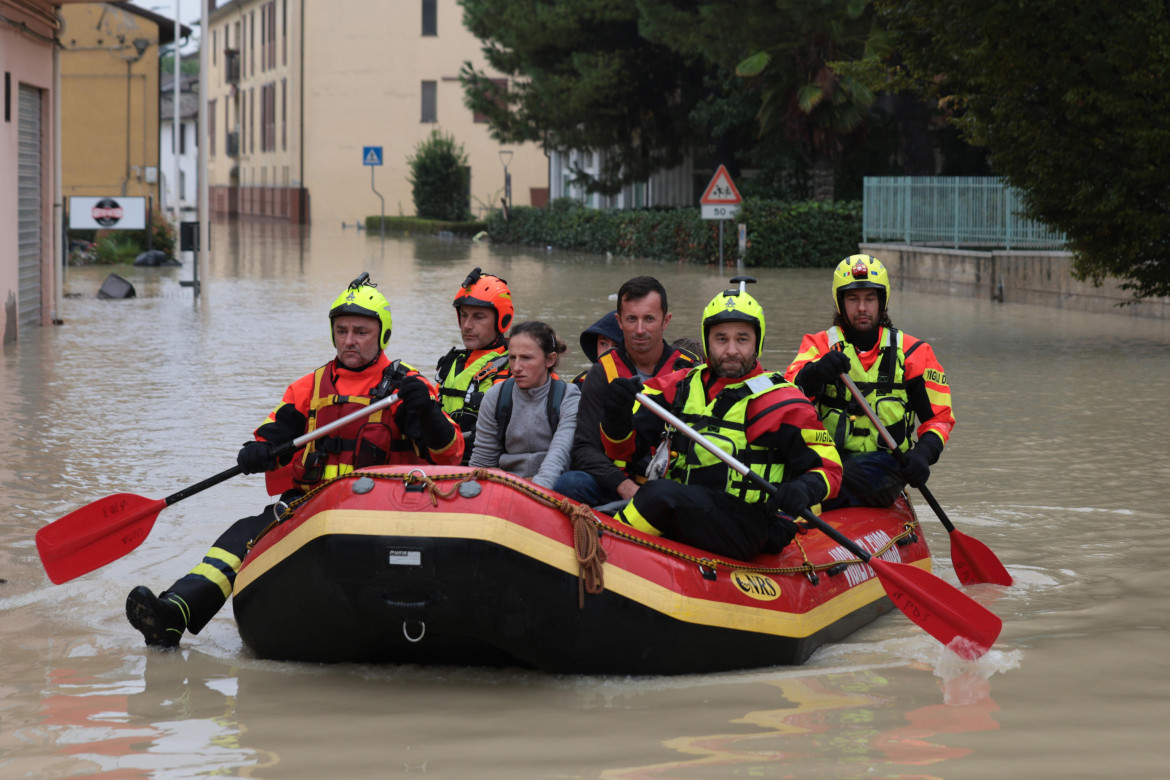Analysis
Another man-made deluge on Emilia-Romagna and ‘political profiteering’ from the government
These are the consequences of anthropogenic global warming, which is causing increasingly frequent and violent weather cataclysms. But there wasn’t a word about it from the denlialist government.

The experts said that the May 2023 rains in Emilia-Romagna had been a 200-year event. Instead, a new deluge came again 16 months later, with even higher intensity: 350 millimeters of rain fell in just 48 hours, while a year and a half ago it had been 400 mm for the entire month.
From the Apennines to the plains, the same territories were hit that had been affected by the previous flood, albeit to a smaller extent, with landslides and extensive flooding. The areas around Ravenna, Forlì-Cesena and Bologna were the hardest hit: 4 rivers flooded, 1,000 people displaced. The stormy seas prevented waterways from draining and eroded the beach in the Rimini area. The disturbance also hit the Marche region, causing flooding in Ancona and landslides in San Benedetto del Tronto. These are the consequences of anthropogenic global warming, which is causing increasingly frequent and violent weather cataclysms.
The reason why there was less damage and no casualties reported this time (although the fate of two missing people in Bagnacavallo remains unknown at this point) is because the rainfall fell on drier soil, ready to absorb water. Prevention also worked: with the memory of the dramatic event still fresh, warnings were issued, the level of alert was high, evacuation orders were obeyed. But there is still a looming question about the fate of this very fragile territory, more exposed than the rest of the peninsula to the consequences of the climate crisis, with the aggravating factor of excessive cement cover that makes the soil impermeable.
Until some years ago, Emilia-Romagna was associated with a good quality of life; now it is perceived as a polluted and overbuilt region, where people lose sleep every time there are heavy rains, and which risks becoming unlivable. Thinking about adaptation will have to be the priority of whoever will govern the region after November’s elections; but so far, this has not been the focus of debate among the candidates.
The situation began to turn critical on Wednesday afternoon, when it had been raining for more than 24 hours. The first levees broke during the night and on Thursday morning. The Marzeno, Senio, Lamone, and Montone rivers overflowed in several places, flooding parts of Faenza, Lugo, Castelbolognese, Bagnacavallo, Casola Valsenio, Forlì and Modigliana. A regional order closed down school and suggested avoiding travel. Rail traffic was suspended. In Traversara, Ravenna, the force of the water caused the walls of some houses to collapse, and firefighters rescued residents from rooftops. The red alert remained in effect for Friday: the rains were expected to be less intense, but would come down on weaker and more compromised soil.
While all this was happening, the Meloni government had nothing better to do than to engage in petty political attacks. The main protagonists were Civil Protection Minister Nello Musumeci and Deputy Infrastructure Minister Galeazzo Bignami, who called a joint press conference to stress that “structural and infrastructural prevention is the responsibility of the regions.” The two repeated several times that they “don't want to engage in political polemics,” and then proceeded to do just that, attacking the regional PD-led administration of Emilia-Romagna: “What happens when it rains heavily is the result of what we did and didn’t do in normal times,” the minister said, recalling that “Emilia-Romagna is one of the regions with the highest cement coverage, and this fuels water runoff.”
Musumeci insinuated that the Bonaccini administration hadn’t spent all the money allocated by the government after the 2023 floods, which, he claimed, “happened because the territory was not prepared in previous years,” and said the region had received nearly 600 million euros in the past 10 years for ordinary interventions against hydrogeological instability. He demanded that the regional administration “make the effort to tell us how they spent this money.” There was not a word from any of them about the anthropogenic causes of the event; but nothing else could be expected from a climate denialist government.
PD secretary Elly Schlein hit back immediately: “The right-wing government immediately got down to the business of political profiteering for electoral purposes.” We spoke by phone to Ravenna Mayor Michele De Pascale, the candidate for the center-left in the region, who he told us he was “focused on managing the emergency. I thought the press conference would give useful information about the situation; but when I realized it had been called just to engage in political attacks, I turned off the TV and got back to work.”
After the emergency, he said, it will be necessary to rethink land management. “Repairs are no longer enough,” De Pascale stressed. “The water affected areas where adequate post-flood maintenance had been done. It will need to be addressed at a structural level; there needs to be a broad rethinking, and it needs to be quick.” Hopefully, it will start with acknowledging the mistakes of the past.
Originally published at https://ilmanifesto.it/diluvia-sul-bagnato-in-emilia-romagna-e-ancora-emergenza on 2024-09-20
